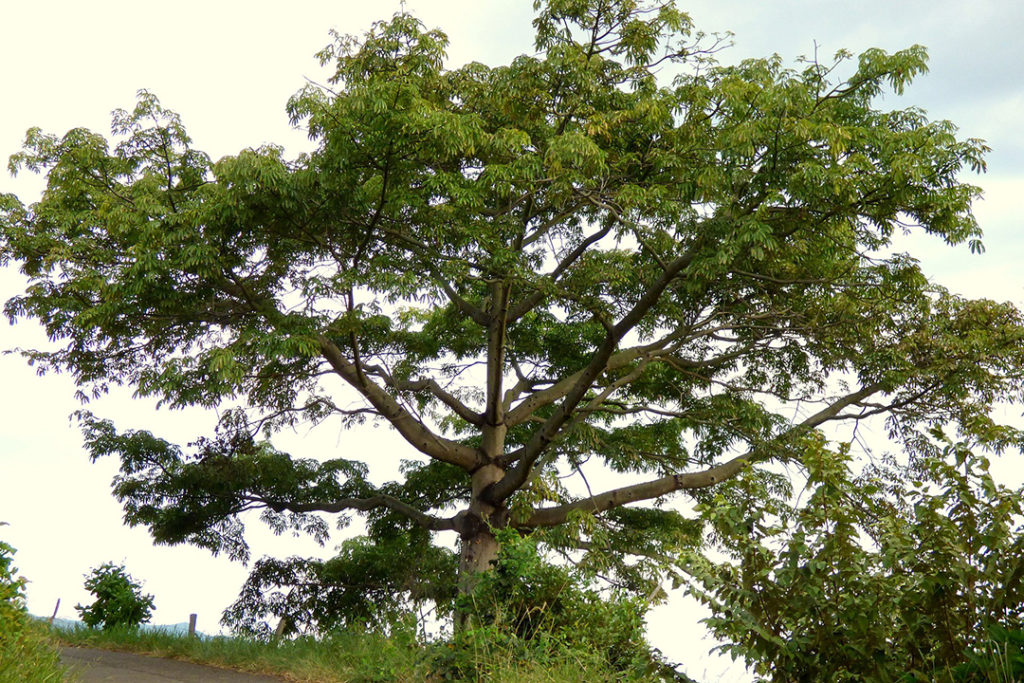
Equatorial Guinea
Ceiba
Ceiba pentandra

General Description / Cultural Significance
Ceiba, or Ceiba pentandra, is a tall tree that can grow up to 70 meters in height, one of the tallest trees in the world. Seen from a great distance away, its round crown towers above all the other trees. It is identified on the ground by its buttress roots. The tree is also a towering, pervasive, and powerful symbol in the minds of Equatoguineans, and are known to live five hundred or more years. Ceiba is not only the national tree, it is depicted on the national seal and flag of Equatorial Guinea, along with a band of green that symbolizes the country’s abundant plant biodiversity. Additionally, it is the name of their national airlines and main bank. It follows that the tree is protected by the state with a tremendous, essentially unaffordable fine for cutting one down.
In colonial times, King Muganda famously planted a ceiba tree on the largest island of the country—the Bioko Island—and made a deal with Portuguese settlers. He circled the new tree with a chain, and they agreed that once it grew large enough to break it, the Portuguese would leave the country. The ending was not storybook, but eventually the people forced the Portuguese to respect the promise made by their ancestors.
The ceiba is more than a national emblem. The tropical tree is deeply integrated into the culture in diverse ways, but primarily as medicine, fiber, and timber. The tree’s leaves, bark, and gum are used in a variety of ways to treat a myriad of illnesses and conditions, including mental illness, for which a leaf sap beverage is consumed. The ceiba is used to treat fevers, relax spasms, stop bleeding, and treat diabetes. Its bark is a known aphrodisiac, and sometimes decoctions are added to the psychedelic drink Ayahuasca.
The yellowish fiber contained in the seeds of the tree was historically used as a filling for a sundry of items, including mattresses and life jackets. Its use in this way declined after synthetic alternatives became more popular. Currently, its timber is mostly used to make boxes, crates, canoes, utensils, and furniture. The seed itself also yields an oil that is used in soap and fertilizer. The tree’s fragrant night-blooming flowers are an important source of nectar and pollen for honeybees and bats. This multipurpose tree provides for both people and wildlife of Equatorial Guinea.
Climate Change/Conservation Status
Equatoguinean forests cover much of the country. The trees not only contribute to the economy, but are so vast that they can also contribute to mitigating the effects of climate change. Forest management is key when it comes to conserving biodiversity in the country, and in 2019, Equatorial Guinea reaffirmed its commitment to reduce carbon emissions and deforestation. Funding has been allocated for this mission. In 2020, the country issued a presidential decree to ban logging of certain trees, because of ecosystem endangerment.
Although it is a highly protected tree in Equatorial Guinea, according to the IUCN, harvesting of ceiba in general is considered unsustainable and it is a vulnerable species in the Dominican Republic. It is necessary to monitor trends relating to the tree’s use as timber, in all countries. It is particularly difficult to measure and monitor large trees like the ceiba tree because of their height, but efficiency in this realm is vital to understanding the effects of both harvesting and climate change.
Alternate Names
Cotton tree
Java cotton
Java Kapok
Kapok
Sources
Climate Links, 2018. Climate Risk Profile: West Africa. U.S. Agency for International Development [ebook]
Embassy of Equatorial Guinea, Washington, D.C. This statement can be found on the World Sensorium original website.
Lewis, M.A., 2007. An Introduction to the Literature of Equatorial Guinea. University of Missouri Press Columbia and London. [ebook]
Lumosi, C., 2014. Equatorial Guinea Case: Current vulnerability in the Monte Alén–Monts de Cristal landscape. weADAPT. [website]
Nematchoua, M., Orosa, J., & Reiter, S., 2019. Climate change: Variabilities, vulnerabilities and adaptation analysis – A case of seven cities located in seven countries of Central Africa. Urban Climate, [website] 29, p.100486. DOI: 10.1016/j.uclim.2019.100486
Ngoua-Meye-Misso, R., et al., 2019. Medicinal plants used in management of cancer and other related diseases in Woleu-Ntem province, Gabon. European Journal of Integrative Medicine, [website] 29.
McSweeney, C., New, M., & Lizcano, G., 2019. UNDP Climate Change Country Profiles: Equatorial New Guinea. United Nations Development Programme. [ebook] pp.1-3.
What-When-How, n.d. Equatorial Guinea (Global Warming). The Crankshaft Publishing. [website]

